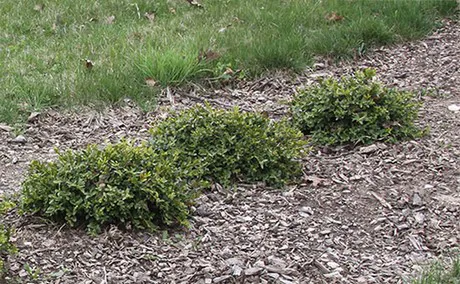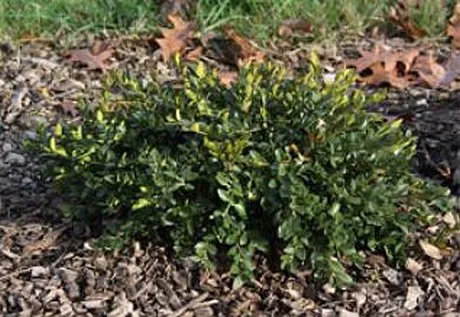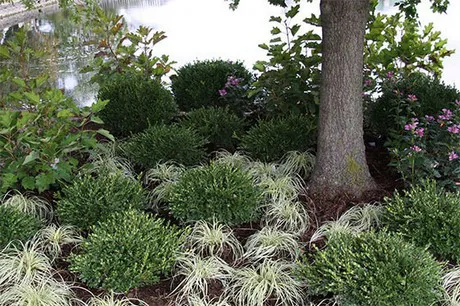Buxus Flat-tery, selected by Michael Yanny of JN Plant Selections, is “shaping up” to be a sought after boxwood due to its unique, prostrate habit, Zone 4 hardiness and extended juvenile growth period which means a green winter color and few fruit pods.

Grower and propagation partner Mark Richey of Richey Nursery Company says, "When describing Buxus Flat-tery to customers, we say just think of a Chamaecyparis Mops; it has the same shape, which is totally different than any other boxwood on the market."
This new favorite will appeal to designers looking for compact, prostrate broadleaf evergreens for landscapes and container gardens. It’s equally at home as a medium-height groundcover as it is performing in container combos. Its name aptly describes its shape: wider than it is tall. With its small, fine-textured glossy green leaves and a low-growing habit, designers can get the look of cotoneasters without their associated problems. Excellent for adding texture to shade gardens when paired with hosta, ferns, carex, and other shade staples.
The habit
Buxus Flat-tery originated from a seedling of ‘Green Velvet’ that was planted in 1989. It was one of 100 plants that were screened from a crop of about 1000 seedlings for superior hardiness in Wisconsin conditions.
Breeder Mike Yanny noticed that the low growing form of this particular plant was similar to the popular Picea abies ‘Nidiformis,’ Nest Spruce. “I was not familiar with any hardy boxwoods with this kind of form in commerce,” he says, so he moved ahead with propagation. He says that, to this day, “the original plant, from 1989 seed, has very few flower buds on it and still retains its rich, bright green juvenile foliage.”

The color
In comparison to other boxwoods, Buxus Flat-tery stays in its juvenile phase longer than most, resulting in fewer fruit pods and a lasting green winter color. Consumers will love the colorfast nature. Nobody enjoys a brown boxwood.
Anthony Hoke from Silver Falls Nursery (one of the main propagating nurseries) says, “We’ve been growing Buxus Flat-tery in trial beds and four inch pots in the nursery and we’re very excited to offer it commercially.”

The details
- Height & spread: 24” tall by 4’ wide
- Flower: Very few, because it remains juvenile
- Cold hardiness: Zone 4
- Light: Part shade to full shade
- Soil: Prefers moist, well-drained soil, pH 6.0-8.0
- Landscape uses: Groundcover or green accent in shade garden
- Propagation: Summer or winter cuttings
For more information:  Silver Falls Nursery
Silver Falls Nursery
503-874-6525
[email protected]
www.silverfallsnursery.com
 Richey Nursery Company
Richey Nursery Company
800-798-4079
[email protected]
www.shrubliners.com
